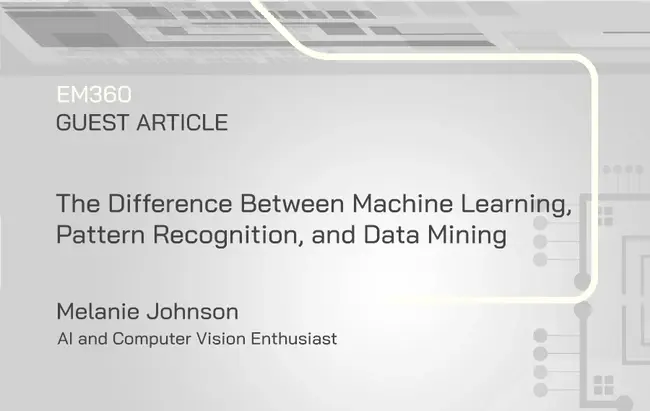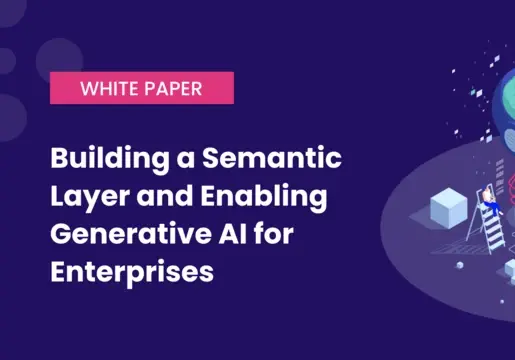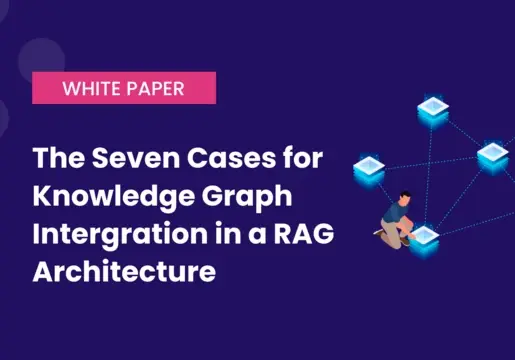This article was written by Melanie Johnson, AI and Computer Vision Enthusiast.
ML, data mining, and pattern recognition are highly fundamental topics used in the automation field with AI. The approaches and the objectives behind these three areas create significant confusion due to the limited technical knowledge among people. All of them form critical parts of the digital age, helping in business functionality and advancements in technology. A significant number of industries rely on these three fields to thrive and approach challenges affecting their operations and expansion in the global market. The information provided here will be of great use to those willing to pursue these areas professionally or those who seek to understand their differences.

Pattern Recognition
This field of AI started back in the 1950s. During this time, practitioners and researchers were developing interests to build systems that would be used in optical character and speech recognition. In this field, the researchers and practitioners focus on developing and designing machines to recognize or group patterns such as images, signals, objects, and processes through sensing approaches or mechanisms. Pattern recognition allows industries to have unique and strategic benefits, which facilitates improvement and steady evolution. This can be referred to as a strategic advantage in the ever-changing world. The process involves segmenting and then differentiating data as per set criteria or common elements assisted by unique algorithms. This creates room for improvement, forming a fundamental area of machine learning. Machine learning technology requires pattern recognition as an integral part where patterns are identified in data helping to generate stories or information through flat lines, spikes, flows, and ebbs. The collected data may be in the form of sound, images, or texts.
The Process of Pattern Recognition
- Gathering data from sources via tracking or inputs.
- Swabbing of data from noise.
- Scrutinization of information retrieved to form relevant elements and characteristics.
- Grouping of the features/ elements.
- Examination of categories/ classes, therefore, generating sets of data.
- Execution of derived insights to facilitate industrial or business operations.
Applications of Pattern Recognition
- Optical Character Recognition: It is used in processing handwritten materials, documents, signatures, and text transcription.
- Processing of Natural Language: This includes text analysis, transcription, and generation. For instance, in plagiarism detection and translation of one language to the other.
- Data analysis: For instance, forecasting the stock market using comparative studies to generate and predict the possible outcomes.
Machine Learning
ML is a field of AI that helps computers analyze gigantic sets of data and learn the patterns involved to help computers predict and make conclusions. The computers do not need man intervention to comprehend or interpret the given data. ML involves training/ teaching the computer to behave like human beings to help it interpret information to carry out various tasks. This helps in gathering accurate predictions that promote decision-making. Machine learning may involve training the computer to identify specific objects, images, people, or any other form of data to come out with the desired outcome. For instance, a computer may be trained to understand traffic objects and concepts to help develop self-driving cars which can visualize and process all objects on the road while enhancing safety and efficiency.
ML is divided into unsupervised and supervised learning and other minor forms such as clustering algorithm, regression, semi-supervised learning, and Bayesian learning algorithm. Supervised learning exposes computer systems to numerous sets of data that are labeled. During this type of learning, the system identifies various clusters of pixels and other shapes linked with every figure helping the computer recognize handwritten figures. On the other hand, unsupervised learning involves the identification of specific data patterns. The system is taught to acknowledge similarities by dividing data into categories. In the end, ML employs data mining models and other forms of training data/ algorithms to generate models for future predictions. ML started later in the 1950s, utilizing existing data and algorithms.
Applications of Machine Learning
- Neural networks
- Computer vision
- Web-search
- Fraud detection and credit scoring
- Spam filter
- Computer design and other cognitive services.
Data Mining
Data mining/knowledge discovery involves discovering and identifying beneficial insights from total data volumes stored in databases and data warehouses. It started earlier but was perfected in the 1990s and required human intervention. Data mining is helpful in decision-making processes, especially in business industries. The process involves various techniques: regression, clustering, decision tree, and analysis of the sequential pattern. It utilizes the discovery of knowledge and effective practices from vast volumes of data. The data is extracted from the raw data such as photos, videos, and other forms of transactions and then automatically processed to produce reports. The reports are then used by businesses to make decisions. Companies can discover patterns and trends through compiling data and retrieval of relevant information. Data mining is essential as it uncovers hidden patterns through sequence analysis and classification.
Data Mining Steps
- Mining
- Modeling
- Evaluation of pattern
- Presentation of Knowledge
Data Mining Processing
- Acquisition of data
- Cleaning of data
- Reduction of data
- Transformation of data
Applications of Data Mining
- Telecommunication firms
- Intrusion prevention and detection
- Financial data analysis
Key Takeaways
Understanding ML, pattern recognition and data mining is critical for today’s technology. These are unique concepts that promote technology advancement, such as improving the functionality and success of a business. Despite their differences, they are used together to improve the technology by enhancing business operations. ML ensures that computers learn in order to make predictions and decisions. Data mining is an important process as it helps discover knowledge by identifying beneficial insights from critical data volumes from databases and warehouses. Lastly, pattern recognition involves segmentation and distinguishing data into certain elements or criteria using unique algorithms.
The difference appears between the two during data analysis approaches, applications, and the role they play. Data mining is reliant on existing sets of data in order to establish patterns, while ML utilizes training sets of data to teach the computer how to process and make sense of the processed data. Therefore, data mining is heavily used in retail to determine trends in sales and customer purchasing behavior, fraud detection, financial planning, and forecasting sales, while ML provides in-depth, accurate insights and often in real-time to enable improved shopping and customer experience.
Data mining is reliant on manual human decisions and intervention, but in ML, the rules are already in place only required in automatic extraction and learning of the data. In data mining, the analyst combines massive unstructured or structured data for studies without processing it, while in ML, the analyst learns from the gathered data to become intelligent and experienced. ML is a step of data mining that helps develop algorithms that are needed in learning. ML utilizes the algorithmic models in order to access the existing properties and then learn while data mining designates processes with a significant application focus. It extracts beneficial existing data patterns such as business data. Pattern recognition plays a part in ML by enabling computers to learn and process that information. ML utilizes data to learn, while pattern recognition helps to identify patterns. Pattern recognition uses ML algorithms to recognize patterns and other regularities found in data.








Comments ( 0 )